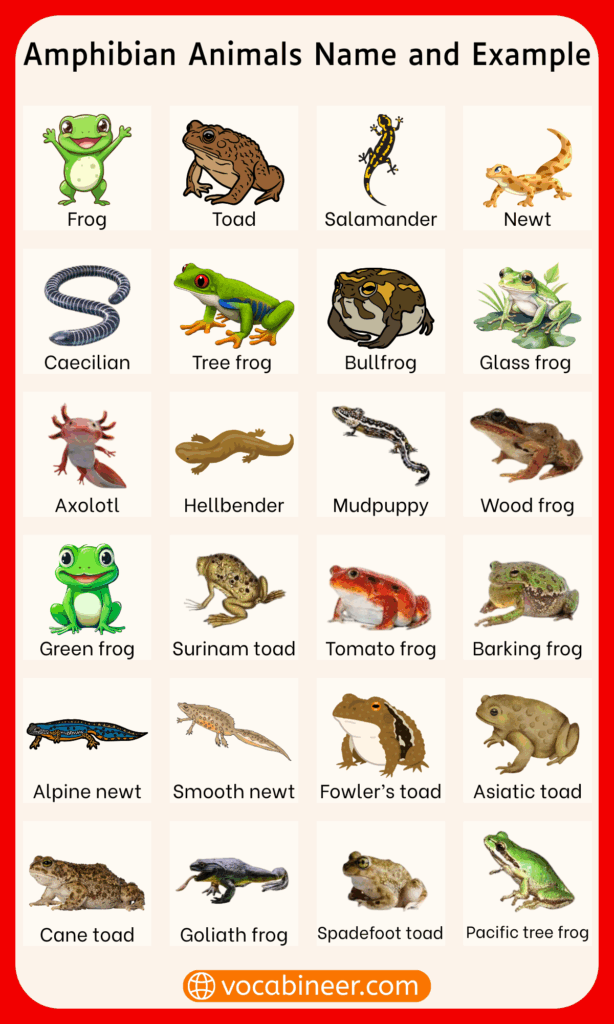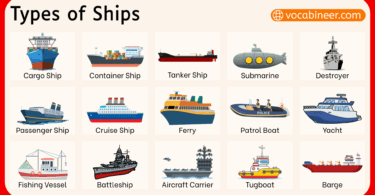Amphibians are cold-blooded animals that live both in water and on land during their life cycle. They breathe through gills or lungs, have moist skin, and most lay eggs in water. Frogs, salamanders, and caecilians show this diversity. By learning amphibian animals name with their pictures, readers can recognize species more easily and use these names confidently in schools, travel, or science talks.
In This Page
List of Common Amphibian Animals Name
Common amphibians are species students often learn first in biology. They include frogs, toads, salamanders, and newts, each showing unique traits. Below is a list of common amphibian animals name explained simply.
Frog: Frogs have smooth skin and long legs for jumping. They live near rivers, ponds, and forests.
Toad: Toads have drier, rough skin compared to frogs. They adapt to land but return to water for breeding.
Bullfrog: Bullfrogs are large frogs with loud calls. They are common in ponds, lakes, and swamps.
Leopard Frog: Leopard frogs have spotted skin. They are common in North America and used in biology lessons.
Salamander: Salamanders are amphibians with tails. They live in moist forests and breathe through skin or lungs.
Newt: Newts are salamanders that live both in water and on land during their lives.

Types of Amphibians
Amphibians are grouped into three main types, each with different traits and habitats. These include frogs and toads, salamanders and newts, and caecilians. The types of amphibians are explained below with simple details.
Anura (Frogs and Toads): Includes all frogs and toads. They are tailless and skilled jumpers.
Caudata (Salamanders and Newts): Includes salamanders and newts. They have elongated bodies and tails.
Gymnophiona (Caecilians): Caecilians are legless amphibians. They resemble worms and live underground in tropical regions.
Amphibian Animals That Live in Water
Some amphibians spend nearly their whole lives in aquatic habitats. These species depend on water for breathing, movement, and feeding. Below are amphibian animals that live in water explained with their unique traits.
Aquatic Frogs: These frogs stay in water most of the time, unlike tree or land-dwelling frogs.
Axolotl: Axolotls are salamanders that stay juvenile. They keep gills and remain aquatic for life.
Siren: Sirens are eel-like salamanders with gills. They live in swamps and slow-moving waters.
Mudpuppy: Mudpuppies are aquatic salamanders with feathery gills. They live in rivers and lakes in North America.
Amphibian Animals That Live on Land
Some amphibians adapt to living mainly on land while still returning to water for breeding. These species thrive in forests, gardens, or soil. Below are amphibian animals that live on land explained clearly.
Tree Frog: Tree frogs have sticky toe pads. They climb plants and live in forests and gardens.
Toad Species: Many toad species burrow in soil. They survive in dry areas but breed in ponds.
Red-Eyed Tree Frog: These frogs are famous for their bright red eyes. They live in tropical rainforests.
Unique Amphibian Animals Name
Some amphibians are recognized for their unusual looks or rare behaviors. These species stand out among others in this group. Below is a list of unique amphibian animals name explained for better understanding.
Glass Frog: Glass frogs have transparent skin on their bellies. Internal organs can be seen through their bodies.
Poison Dart Frog: These frogs are brightly colored. Their skin toxins defend them from predators.
Hellbender: Hellbenders are giant salamanders. They live in rivers of North America and can grow very large.
Surinam Toad: Surinam toads are unique. They carry eggs in their skin, which hatch on their backs.
Darwin’s Frog: Darwin’s frogs are small amphibians. Male frogs protect tadpoles inside their vocal sacs until grown.
Endangered Amphibians
Many amphibians are now endangered because of pollution, habitat loss, and climate change. These species face serious survival risks. Below is a list of endangered amphibians explained with their important traits.
Chinese Giant Salamander: The largest amphibian in the world. It is critically endangered due to habitat loss.
Golden Toad: Once found in Costa Rica, the golden toad is believed extinct due to climate change.
Axolotl: Also endangered, axolotls face threats from habitat loss and pollution in their native Mexico.
Other Interesting Amphibian Animals
Besides the common and unique species, there are other amphibians worth mentioning. These animals add variety to the group. Below is a list of other interesting amphibian animals explained with simple details.
Caecilian: Caecilians are legless amphibians. They burrow underground and live in tropical regions.
Olm: Olms are cave salamanders. They are blind and live in underground waters in Europe.
Tiger Salamander: Tiger salamanders are large, spotted amphibians. They are widespread in North America.
Conclusion
Learning amphibian animals name with pictures helps readers understand this diverse group. From frogs and toads to salamanders, newts, and caecilians, amphibians show unique traits that connect land and water life. Knowing their names makes science, travel, and classroom discussions easier and more meaningful.
FAQs about Amphibian Animals Name
The three main types of amphibians are frogs and toads (Anura), salamanders and newts (Caudata), and caecilians (Gymnophiona). Each group has unique traits and habitats.
The Chinese giant salamander is the largest amphibian. It can grow over 5 feet long and is critically endangered.
No, amphibians cannot live only on land. They need water for reproduction, and many depend on moist habitats.
Some amphibians remain fully aquatic, such as the axolotl, siren, and mudpuppy. They keep gills and never fully adapt to land.
Amphibians are endangered due to pollution, habitat loss, climate change, and disease. Species like the golden toad have already gone extinct.
Read More




